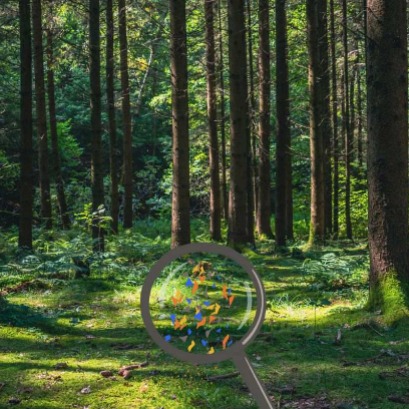
New German study discovers that forests store up to one million microplastics per square meter after decades of plastic rain
Researchers at the Technical University of Darmstadt discovered that forest floors contain large amounts of microplastics, which arrive mainly through air.
? Microplastics in forest soils.? Main route: atmospheric deposition.? Forests as natural traps.? Since the 1950s, continuous accumulation.? Pollution comparable to urban areas.? Effects on the ecosystem still uncertain.Plastic rain: forests are trapping microplastics from the skyWhen thinking about plastic pollution, attention usually focuses on oceans, rivers or even agricultural environments. However, a new study carried out by the Darmstadt Institute of Technology (TU Darmstadt) breaks that pattern. Researchers have discovered significant concentrations of microplastics in forest soils, demonstrating that even the most remote ecosystems are exposed to airborne plastic pollution. Microplastics falling from the sky Unlike agricultural soils, where the use of fertilizers and compost contaminated with plastics is common, forests have no obvious sources of direct pollution. However, the air does. The atmosphere has become a transport route for microplastics, which travel hundreds or thousands of kilometers from their points of origin until they are deposited in the treetops. The leaves function as natural filters. With every autumn rain or fall, trapped plastics descend to the ground. This phenomenon, described as the comb effect, transforms the forest canopy into a network for capturing air pollution. It is a silent, continuous and practically invisible process. Soil as a plastic file Once microplastics reach the ground, they do not remain on the surface. Natural processes in the forest?such as the decomposition of leaf litter and the biological activity of insects and fungi?pull particles into deeper layers. Thus, soils become long-term reservoirs of this form of pollution. The team recorded concentrations of between 120 and more than 13,000 particles per kilogram of soil, and up to almost one million particles per square meter in some points. This shows that the plastic load in forest soils can equal, and even exceed, that of urban or agricultural soils. What are these plastics made of? The chemical analysis identified that the predominant polymers are polypropylene, polyethylene and polyamide, common materials in packaging, textiles and mass consumption products. Most of the particles were tiny fragments or thin films, smaller than 250 micrometers, imperceptible to the naked eye and with a high potential for dispersion. The similarity between the plastics found on the surface of the leaves and those in the soil indicates that the main source is atmospheric deposition, not human activities within the forest itself. Practices such as wood harvesting or human traffic contribute a tiny fraction in comparison. An accumulation that has taken decades. The researchers calculated that the current levels of microplastics in forest soils coincide with a progressive deposition since the mid-20th century, coinciding with the global boom in plastic production in the 1950s. That is, forests have been capturing microplastics for more than 70 years. years, without anyone knowing. This discovery turns forest soil into a kind of ?fossil record? of human impact in the era of plastic. Every centimeter of land tells a story of consumption, dispersion and environmental neglect. Pollution comparable to urban pollution Perhaps the most alarming thing about the study is that the levels of microplastics in German forests rival those found in urban soils, where plastic pollution is more evident and constant. This dismantles the idea that forests are isolated from the environmental problems generated by human activity. This type of monitoring has strategic value. If forests capture what falls from the sky, they can help map the global distribution of this form of pollution, even in areas where there are no clear local sources. Risks for ecosystems and for people Although the specific impact of microplastics in forest soils is still being investigated, there are already indications that they can alter soil structure, affect microbial activity and modify nutrient cycles. This could weaken natural regeneration, disrupt the food chain and make it difficult for forests to adapt to climate change. Furthermore, the fact that these particles travel through the air means that they not only affect the natural environment, but also human health. Such small plastic particles can be inhaled, and although the long-term effects are still unclear, recent studies suggest possible impacts on the respiratory and cardiovascular systems. The intersection between plastic pollution and the climate crisis paints a worrying scenario: already vulnerable forest ecosystems face a new pressure that is invisible, persistent and difficult to reverse.
IT MAY INTEREST YOU
 Combilift Unveils the 2025 Christmas video “Twelve Days of Christmas” – with a Twist!
Combilift Unveils the 2025 Christmas video “Twelve Days of Christmas” – with a Twist!
Monaghan, Ireland – November 2025
 Nation reinforces prevention and training against forest fires
Nation reinforces prevention and training against forest fires
The director of the Federal Emergency Agency (AFE), Santiago Hardie, referred to the support that the Nation provides in fighting fires. He argued that the majority of igneous sources respond to human interventions and that, therefore, social awareness is a central tool to reduce environmental, material and human damage.
 The DNA of forests: they discover what makes a tree resist drought
The DNA of forests: they discover what makes a tree resist drought
An international team, with the participation of INTA and Conicet, discovered that genetics can be decisive for trees to better resist droughts





















